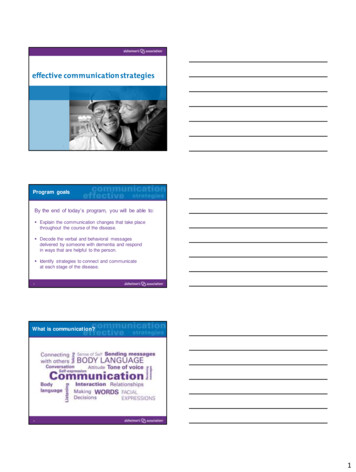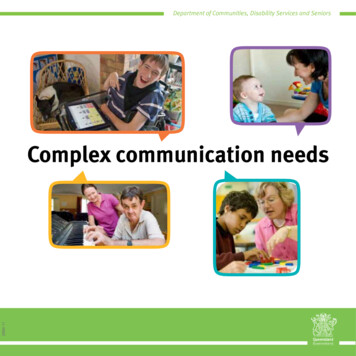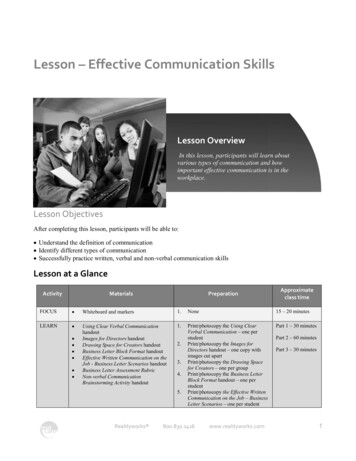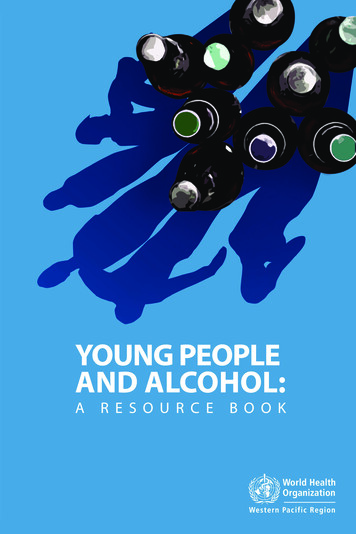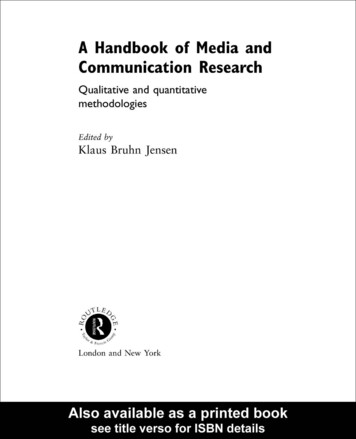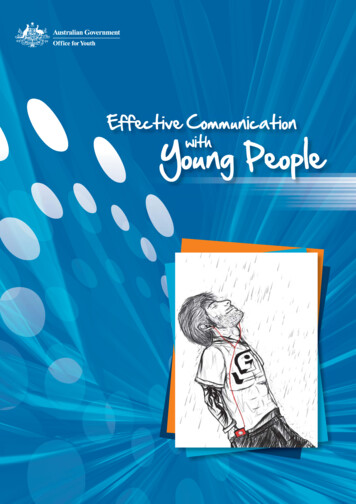
Transcription
Effective CommunicationwithYoung People
Commonwealth of Australia 2009This work is copyright. Apart from any use as permitted under the CopyrightAct 1968, no part may be reproduced by any process without prior writtenpermission from the Commonwealth. Requests and inquiries concerningreproduction and rights should be addressed to the Commonwealth CopyrightAdministration, Attorney General’s Department, Robert Garran Offices,National Circuit, Barton ACT 2600 or posted at http://www.ag.gov.au/ccaThis report is written and issued by Patrick Shanahan and David Elliott whowere engaged by the Department of Education, Employment and WorkplaceRelations to conduct an investigation into communicating effectively withyoung people.The report represents the views of the authors and those interviewed anddoes not necessarily represent the views of the Australian Government, orindicate a commitment to a particular course of action. The AustralianGovernment makes no representation or warranty about the accuracy,reliability, currency or completeness of the report.You should exercise your own independent skill and judgement before yourely on the report. The report is not a substitute for independent professionaladvice and users should obtain any appropriate professional advice relevantto their particular circumstances.This project was made possible with funding from the Australian GovernmentOffice for Youth and the Vocational Education and Training Branch in theDepartment of Education, Employment and Workplace Relations (DEEWR)and the Australian Government Department of Agriculture, Fisheries andForestry (DAFF).This report was prepared for use by Australian Government agencies.Feature image designed by Congao (Oliver) Ma from Victoria
Effective Communication with Young PeoplePatrick Shanahan and David ElliottReport for:Office for Youth, DEEWRE&S Research Pty LtdDecember 2009
2
ForewordThe Effective Communication with Young People report was commissioned by the Office for Youth in theDepartment of Education, Employment and Workplace Relations.The intended audience for this report is primarily Australian Government agencies who are planningcommunication activities aimed at young people aged between 12 and 24 years.This report sits alongside the State of Australia’s Young People and Investing in Australia’s Young Peoplereports. In combination, these reports demonstrate the Australian Government’s commitment tounderstanding young people’s needs and its determination to work with young people.The State of Australia’s Young People tells us that there are sound social and economic reasons forgovernments to invest in lifting outcomes for all young people. Investing in Australia’s Young People showshow and where the Australian Government is investing in programs and initiatives for and about youngpeople. The Effective Communication with Young People report provides guidance on how to make sure thatAustralian Government initiatives are known, understood and working for young people.This report is a vital piece of work. It will help governments get better at connecting with young peopleand designing programs and services that are youth-friendly and youth-focused. Better connection andcommunication can help young people by making it easier to find information, advice and services if andwhen they need them.The Office for Youth would like to thank the authors of the report and all the young people, stakeholdersand organisations who contributed to its development.For more information, please contact the Office for Youth: ayf@deewr.gov.auEffective Communication with Young People3
ContentsSummary1.2.3.49MethodologyInfluences on the lives of young peopleInformation and entertainmentSegmentationImportance of technologyYoung people and communicatingFace-to-face communicationMobile phones and textingEmail and social networking sitesCommunication directed to young peopleGovernment and young peopleAwareness and relevanceGovernment communicationEngaging with governmentMethods of communicating with governmentCommunication expectationsYoung l aims1.3Specific aimsReferences31323234Methodology352.12.22.3Stage 1: Literature reviewStage 2: Stakeholder/expert interviewsStage 3: Research among young people2.3.1Scope and structure of the research2.3.2Discussion and interview 5353539404041Summary of literature review423.1Young people today3.2Young people’s activities, interests and expectations3.3Communicating3.4Role of the internet3.5Young people and government3.6Impact of computer technologyReferences42434343444546
4.5.Stakeholder perceptions of young people484.14.24.3Influences on young peopleSegmentationHow young people communicate: the role of technology4.3.1Importance of technology4.3.2Need for instant communication4.3.3Technology enables multi-tasking4.3.4Technology and social engagement4.3.5Face-to-face communication4.4Communicating with young people4.4.1Experiential communication4.4.2Communicating by mobile4.4.3Viral communication4.4.4Combination media4.4.5Social networking sites4.5Young people and government4.5.1Perceptions of government4.5.2Engaging with government4.5.3Barriers to engagement4.5.4Get young people involved4.5.5Provide instant feedback4.5.6Government use of existing social networks4.5.7Government website for young people4.5.8Chat rooms and forums4.6Message do’s and don’ts4.6.1Listen to young people4.6.2Understand your audience4.6.3Encourage participation4.6.4Content4.6.5Endorsement4.6.6Use of a third 162626263656565666667707171Young people and ces on the lives of young ers5.1.4Workmates/employers5.1.5Media5.1.6Other influences5.2Information and entertainment sources5.2.1The internet5.2.2Television5.2.3Print media5.2.4RadioEffective Communication with Young People5
6.5.3Young people and traditional forms of communication5.3.1Face-to-face communication5.3.2Landline telephone5.3.3Mail5.4Technology and communication5.4.1Overview5.4.2Communicating with each other5.4.3Communicating with others5.5Mobile phones and texting5.5.1Mobile phones5.5.2Texting5.5.3Text language5.6Communicating via the internet5.6.1Email5.6.2Social networking5.6.3Other elements of technology5.7Communicating with young people5.7.1Segmentation5.7.2Communication directed to young people77777878787880808181838485858689909091The government and young 8108109Who is the government?PoliticiansRelevance of governmentGovernment communication6.4.1Electioneering6.4.2Issues communication6.4.3Importance and credibility of communication6.5Engaging with government6.5.1General attitudes6.5.2Methods of communicating with government6.5.3Issues important to young people6.6Communication expectations6.6.1Issue and content of message6.6.2Tone and style7.Regional and rural young people7.17.27.37.46InfluencesInformation and entertainment sourcesMethods of communicationCommunicating with young rural people7.4.1Segmentation7.4.2Communication directed to young rural people110110110111114114114
7.58.Regional and rural young people and government7.5.1Perceptions of government7.5.2Relevance of government7.5.3Government communication7.6Engaging with government7.7Issues important to regional and rural young people116116117118119121Indigenous young people and communication1238.1Influences on Indigenous young people8.1.1In general8.1.2Stakeholders8.1.3Additional consultants’ comments8.2Communicating8.2.1Overall8.2.2With parents and government8.2.3Remote locations8.2.4Stakeholder input8.2.5Additional consultants’ comments8.3Technology and itional consultants’ comments8.4Government communication8.4.1In general8.4.2Stakeholders8.4.3Additional consultants’ comments8.5Demographic comparisons8.5.1Geographic location8.5.2Gender8.5.3AgeAppendix 1: Discussion/interview guideAppendix 2: List of organisations included in the 128128129129130130131131132135Effective Communication with Young People7
8
SummaryThe Australian Government established the Office for Youth (the Office) in September 2008 in an effort toengage with the young people of Australia. The Office will work with other government agencies to helpyoung people reach their full potential; make effective transitions to adulthood as they continue to learn,start work, make decisions that support a healthy lifestyle, live independently and form families andrelationships of their own; and participate in the broader Australian society.This report is one of a number of resources being produced to help the Australian Government developits agenda for young people and to support and assist agencies to achieve outcomes for young people.It investigates effective communication methods for young people, particularly in relation to howgovernment can best communicate with them about the challenges and opportunities they face.MethodologyThe investigation of effective communication methods for young people included three specific phases ofresearch: a literature review to provide an update of current thinking regarding communicating with youngpeople (12–24 years) (The findings of this phase are detailed in greater length in a separate volume.) 49 semi-structured interviews with stakeholders/experts, representing organisations that communicatewith young people 36 group discussions and six paired interviews with young people aged 15–30 years, from culturallyand linguistically diverse backgrounds, representing a range of socioeconomic strata, employed andunemployed, and resident in 11 locations, both urban and rural across Australia (see section 2 ofthe report).Influences on the lives of young peopleStakeholders and young people alike viewed parents as key influences in young people’s lives. Althoughsome younger study participants (15–17 years) were somewhat defiant in their attitude toward parentaladvice, older participants were more likely to accept and appreciate the advice and support of parents.Those in their early twenties viewed parents (particularly mothers) as a ‘sounding board’ and referencepoint for help and advice on their problems and concerns. Stakeholders felt that parents underestimatedtheir influence.Close friends were also singled out as important influences and trusted providers of information andadvice. Young people claimed they often turned to friends for advice on personal, emotional or sensitiverelationship issues. Young people also needed peer group acceptance.Teachers, lecturers, employers and workmates also influence the lives of young people. Young people oftenseek their advice on matters such as choice of education course, career and decisions regarding directionin life.There was unanimous agreement among stakeholders and across the various subgroups of young peoplethat the media has an influence on the lives of young people. TV dramas that have a ‘reality’ feel appealedparticularly to young girls, and reality programs appeared to be a source of influence.The media was thought to influence particular aspects of the lives of young people: fashion, body image,food and beverage trends. Allied to these perceived areas was the influence of the rise of the ‘culture ofcelebrity’, the emergence of people who are ‘famous for being famous’. Stakeholders pointed out that thiswas reflected in young people’s desire to be popular by accumulating ‘friends’ on social networking sitesand uploading clips to YouTube, and to have ‘15 minutes of fame’.Effective Communication with Young People9
The internet, and communication technology in general, is an integral part of the lives of most youngpeople. The inherent benefits of convenience, speed, flexibility and mobility afforded by the newtechnologies are helping shape the culture of young Australians. Most young people embrace thistechnology with open arms (see sections 4.1 and 5.1).Conclusion: Parents and friends are a key influence on young people in terms of providing guidanceand advice on making important personal and career decisions. According to stakeholders, parentsseem to underestimate their influence.Traditional media is also an influence through its role as an entertainment source, and the internet isgrowing in terms of providing information via blogs, forums and social networking sites. The integralrole the internet already has in the lives of young people suggests that it could become a key influencein the future.Information and entertainmentInterestingly, most young people were more comfortable about accepting the role of the media as asource of entertainment than as a potential influence on their thinking or decision making. Many,particularly those aged 18–24 years, adopted a defensive attitude towards the possibility of the mediabeing an influence. The media was often portrayed as an untrustworthy and unreliable source forinformation and was regarded as manipulative and biased in the way it conveys information.Stakeholders pointed out that most young people are media savvy, alert to the potential influenceof the media on their lives and more than capable of applying their own filters on communicationsdirected to them.Television was not always spontaneously mentioned as a source of information. According to most in thestudy, it provides some information on what is happening in the world through news reports and currentaffairs programs. However, despite the increasing use and influence of the internet, television (both free toair and cable TV) still has a role to play, primarily as a source of entertainment rather than information.Drama, comedy programs, music and sport represent the key interest areas on TV for young people.However, some stakeholders and young people in the study suggested that, with the exception of live sportprograms, TV is rapidly becoming outdated. Young males, in particular, want to view sport live. However,live sport programs are no longer the domain of television only, and accessing live programs on theinternet and through mobile phones appears to have increasing appeal.The internet was said to be growing in importance as an information source, a vehicle for socialnetworking, and a provider of entertainment. It was seen as providing an answer to virtually any questionasked of it and, for the most part, a convenient, fast and trusted source of information. Google andWikipedia were the most frequently mentioned internet sites in this regard.Young people use the internet not only to access information and download music and movies, but alsoto socialise (social network sites, instant messaging and internet telephony), watch or share videos onYouTube, conduct retail transactions and banking and keep up with current affairs via news sites. However,social networking sites and YouTube dominated most young people’s use of the internet. Internet accessto entertainment was said to enable young people to watch what they want, when they want, where theywant (often in the privacy of their bedrooms).Young females were more likely than young males to claim readership of magazines. They read themmore for entertainment or recreation than as a source of ‘hard’ information. The print media (newspapersin particular) were spontaneously mentioned as sources of information on employment opportunities,although the internet, through websites such as Seek.com, was becoming more important.10
While radio still has a role to play in the lives of young Australians, it is being challenged by newtechnologies, most notably the iPod. Young people still listen to radio in the morning and some listen to itwhen travelling. Music, comedy and gossipy chitchat have primary appeal in this medium (see section 5.2).Conclusion: The internet offers young people options for sourcing information and entertainment.Its strength is in the ease with which young people can adapt computer technology to the way theylive. The primary role of the internet is as an information source, but it is becoming more importantas a vehicle for social networking and for providing entertainment.More traditional media such as TV, radio and print material still have a role to play in the lives ofyoung Australians. TV in particular is important for live sport broadcasts, news reports and someentertainment elements. Radio also provides young people with a vehicle for music and listening toidle chitchat. However, computer technology in its many forms is increasingly challenging both TVand radio. The increasing importance of computer technology and its rising popularity as a leisuretime activity is reflected in the literature, with new technologies complementing, rather thancompeting with, traditional media such as TV (ACMA 2007, 2008a; Brandstrategy, 2007).SegmentationBoth stakeholders and young people maintained that the population of young people is not homogeneous.The range of different interests, use of a variety of computer technologies and varying degrees of access toservices makes the age range 12–24 years even more heterogeneous than it has ever been in the past. Theperceived diversity among young people was said to make the need for segmentation when communicatingwith them even more important. The population of young people was thought to comprise a variety ofsubgroups and, while some interests, attitudes and behaviours are shared by all young people, there aresignificant attitudinal and experiential differences as well.Across the study there was general agreement that although traditional segmentation variables based ondemographic factors (e.g. age, gender, education levels etc) were valid discriminators, any segmentationshould include consideration of variables such as life stage, attitudes and behaviours. Stakeholderswho worked with young people from culturally and linguistically diverse backgrounds stressed thatcommunicating with these young people has to be even more carefully implemented. The cultural contexthas to be addressed and messages formulated accordingly, with different distribution channels considered.In general, the major subgrouping mentioned was under and over 18 years of age (reaching adulthood at18, symbolised by legal age to drink, drive and vote). Other frequently nominated age splits, with life stage/lifestyle included: 12–14 years—first years in high school, the onset of puberty 15–17 years—final years of school, major exams, decisions on future/career 18–24 years—establishing career, possible further education.Some young people in the study spoke of a transition period (18–24 years) between leaving school andgaining employment. This period was taken up with gaining employment or further education, travellingoverseas or spending time in part-time employment (and working out what they wanted to do withtheir lives). Many young people said that it was during this time that they needed advice, support, helpand information on what to do with their lives. Many were unaware of what services were available andbelieved there was a paucity of services at this time (particularly in rural areas). They relied on the internetand friends to find out where to obtain information and advice on planning their lives.Effective Communication with Young People11
There was no overall agreement on the best channel for communicating to the various subgroups withinthe population of young people. However, it was generally felt that communicating with those at schoolthrough school is still a potentially effective method of reaching young people aged 12–17 years.Communication mediums generally were thought likely to cut across the various subgroups. In this regard,TV, billboards and the internet were mentioned particularly by the young people in the study. However,the content of the message and, importantly, the way in which it is creatively executed was generallyconsidered a more important issue than the medium chosen (see sections 4.2 and 5.7).Conclusion: The diversity of subgroups within the population of young people indicates thatsegmentation is still a valid basis for establishing communication with young people. There was awidespread consensus that the use of traditional demographic factors together with consideration oflife-stage variables is a relevant approach.There was an overall belief that to obtain maximum effectiveness, messages needed to be tailoredto the specific subgroups. As a result, execution qualities may vary and, therefore, pre-testing ofcommunication directed to young people is desirable.Importance of technologyMost young people in the study maintained that they wake up to technology and often use some form ofcomputer technology as the last thing they do before going to sleep. They use technology constantly intheir daily lives. Confirming what young people themselves said in the study, stakeholders maintained thatadvances in technology meant that they could communicate while doing other things. Modern technologygives young people instant contact with their peers. It helps them connect, keep in touch and socialise andit becomes part of their persona.Young people in the study acknowledged the importance of communicating and of communicationtechnology in their daily lives. Advances in computer technology in recent years have given increasedimpetus to the perceived importance of communication and had a profound effect on the lives of youngpeople. Most young people claimed to ‘not be able to live without a mobile phone’, and the computer itselfplays an integral part in their lives: at school or university, at home and in the workplace. The computer,and specifically the internet, is rapidly becoming the most important communication source, particularlywhen in a mobile form.Young people: are very aware of ongoing improvements in communication technology, in particular themicronisation of technology use some form of technology to communicate on a daily basis are increasingly using multi-function devices (e.g. phone/internet) to communicate. The mobile phoneis not just a phone anymore; it’s a mobile computer.Most young people in the study were confident about using technology to communicate on a daily basis.Most had lived their whole lives with communication technology. They embrace it and consider it afundamental part of their lives. They see themselves as constantly changing and evolving with what theyconsider to be evolving technology. Multi-tasking and multi-using technology is their modus operandi.It empowers them in virtually all areas of their lives and influences their confidence and self-esteem(see sections 4.3 and 5.4).12
Stakeholders in the study also maintained that computer technology is integral to the lives of young peopletoday and with technological advances it would become increasingly important. Most felt that the influenceof technology on young people is not a black or white issue and that communicators need to understandthe importance of technology to young people, their attitudes to it and their use of it.Many stakeholders believed young people have a short attention span and are easily and quickly bored.They want instant gratification and results, hence the importance of mobiles, instant messaging sites andsocial networking sites. Boredom was often mentioned as something that is frequently raised by youngpeople and often a key driver behind the decisions they make, whether it be drinking alcohol, taking drugs,speeding on the roads or their reason for use of SMS and social networking sites.Allied to these considerations is the way in which young people use technology. Their communication isgenerally very quick, short, sharp and to the point, hence the popularity of SMS, Twitter, instant messagingetc. However, some stakeholders felt such communication was superficial, rather than deep or emotional.Stakeholders thought (or hoped) that face to face was still the preferred medium for ‘genuine’ or ‘real’communication (see sections 4.3 and 5.4).Conclusion: Virtually all study participants maintained that computer technology is a critical aspectof the way in which young people communicate today. Young people are very much aware of theadvances being made in communication technology virtually on a daily basis. Young people embracewholeheartedly the use of computer technology, in particular the mobile phone, texting and socialnetworking.Recent research has established the high penetration of the internet and broadband in Australianhouseholds (King, 2006). The literature also shows that young people are the early adopters and keyinfluencers of the new communication technology.Young people have grown up with changing technology and they have adapted intuitively to thechanges. Their adoption of communication technology as an integral part of their lives suggests thatcommunicators need to ensure the inclusion of such technology in their communication but, mostimportantly, use it appropriately (Carroll et al. 2002; King, 2006; Suoranta, 2003).Young people and communicatingThe subject matter of the communication and the person with whom they wish to communicate dictatesthe way young people communicate and the technology (if any) they choose to use. For example, theygenerally: discuss important, intimate and personal subjects face to face convey quick, impersonal messages through texting, email or a social networking channel communicate with their peers both face to face and by using computer technology communicate with parents (and other older adults) face to face or by telephone (fixed or mobile) communicate in a formal context, face to face, by email, or both (e.g. attend employment interviewsand email CVs) communicate at work face to face or over the phone (fixed or mobile) (even in this environment someclaimed they email or text on occasion).Effective Communication with Young People13
Most importantly, cost considerations also dictate what form of communication technology young peoplechoose (see sections 5.3 and 5.4).Conclusion: Young people are extremely adept at using technology to communicate with differentpeople in their daily lives. Most pick and choose a specific form of technology according to the natureof the communication and their assessment of the ability of the intended receiver to use the chosentechnology. This pragmatic approach is adopted within the context of their ability to pay for their useof the technology.Computer technology enables young people to maintain considerable flexibility in the way theycommunicate with, and receive communication from, others.The literature refers to the notion of ‘reverse socialisation’, whereby young people may show theirparents how to adapt to social change. It appears that young people may lead the way in regard tonew technologies and the ways in which they are used (Buckingham and Willett (eds), 2006;Mackay, 2008).Face-to-face communicationCommunicating on a face-to-face basis is still the main way in which young people communicate witheach other and with most people in their daily lives. Face-to-face communication provides an intimacynot matched by technology and was considered particularly important for conversation or dialogue onsensitive, personal and important issues. With face-to-face contact there was thought to be less chance ofmessages being misunderstood or misinterpreted. Tonal qualities, emphasis and emotion were said to bemore easily conveyed face to face through voice and facial or body language.For many, face-to-face communication is still the most credible and trusted form of communication,primarily because they believe they have a better chance of judging and assessing the reactions of theperson they are communicating with (see sections 4.3 and 5.3).Conclusion: Face-to-face communication is preferred because it is the most trusted form ofcommunication. It was seen as the most appropriate method for conveying personal, important orsensitive information. Importantly, face-to-face communication enables young people to more readilysee and understand the consequences of their communication.Recent research confirms that young people look for communication that is genuine and believable.Face-to-face communication is the single most important means used by young people tocommunicate with each other (Dunn, 2007; National Youth Roundtable, 2004).Mobile phones and textingMobile phones appeared to be the favourite communication technology for most young participants inthe study, particularly as the more sophisticated phones offer multi-function communication capability.Young people feel uncomfortable and lost without a mobile phone. Mobile phones, together with socialnetworking, dominate young people’s communication.For most young people, mobile phones have become almost indispensable and benefit them in a numberof ways. Mobile phones:14 enable communication anywhere, anytime, provided there is mobile coverage; Users can be in contactall the time are small, convenient, and easy to use enable young people to plan and manage their lives ‘on the run’; there is less need to plan ahead
are more than phones; they are also phone books and, depending on the phone and plan, can belinked to the web, email, games, music, information sources, etc can be status symbols or fashion items or fashion accessories.Young people raised a number of disadvantages associated with the use of mobile phones: Phone calls can be costly, particularly for those living on a restricted budget. Poor coverage is an issue in remote and some rural areas. Mobile phones are less suitable for personal or intimate communication than face-to-face contact(e.g. body language can’t be read). In social settings, using the phone can be considered anti-social. Some young users become so involved or preoccupied with their phone that they exclude face-to-faceconversa
Effective Communication with Young People 3 Foreword The Eff ective Communication with Young People report was commissioned by the Offi ce for Youth in the Department of Education, Employment and Workplace Relations. The intended audience for this report is


